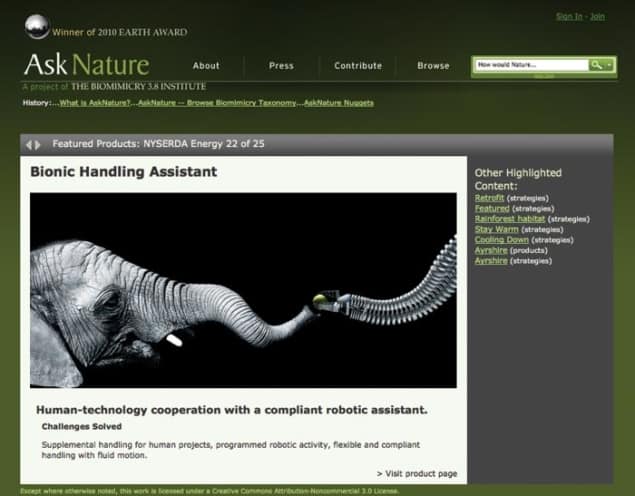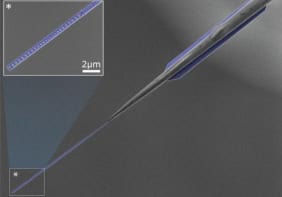Ask Nature
URL: www.asknature.org

So what is the site about?
Ask Nature is a site devoted to biomimicry, an interdisciplinary field in which practitioners study how animals and plants solve problems, and then use those solutions to develop better human technologies. The site lists many instances of technology imitating life, including a surgical bandage inspired by gecko feet, a fog-harvesting mesh inspired by a desert beetle and a ceiling fan inspired by the seed pod of a sycamore tree. In total, there are nearly 200 examples of actual bio-motivated inventions described on the site, but they are just the tip of an iceberg of possibilities. Ask Nature also contains an astoundingly large catalogue of animal and plant strategies that might inspire solutions to human technological problems. Known as the “Biomimicry Taxonomy”, this catalogue contains around 1500 entries.
Can you give me some examples?
The Morpho butterfly keeps itself dry and clean in its rainforest environment thanks to nanostructures on its wings that make them both extremely hydrophobic and self-cleaning. Such structures have inspired new types of paint, textiles and glass that require less labour and fewer chemicals to keep clean. Another rainforest denizen – a medium-sized bird called a toucan – has an outsized beak that can be up to a third of its length, while making up only 5% of its weight thanks to the beak’s foam-like interior structure and thin outer layer. This light-but-strong construction might prove useful in ultralight aircraft components, or perhaps the panels in cars that protect people from injury during crashes. Not all of the taxonomy’s entries are rainforest species, but the richness and sheer biodiversity of these areas does seem to promote the development of novel adaptations. Yet another reason, if one were needed, to be concerned about their disappearance.
How is the taxonomy organized?
Each entry in the Biomimicry Taxonomy is assigned to one of eight “function groups”, which are in turn divided into 30 sub-groups and 162 separate functions. For example, the high-level function group “move or stay put” is split into two sub-groups, called “attach” and “move”. Attachment is further divided between permanent and temporary stickiness, while movement is grouped by travel that takes place in (or on) gases, liquids and solids. This seems sensible enough, but taxonomy is not always an exact science, and the system used in Ask Nature occasionally throws up a few anomalies. For instance, it seems odd that the hairy footpads of the fennec fox (which help it move over desert sand without slipping) are classed under “movement”, while the cloven hooves of the mountain goat (which help it move over rocky terrain without slipping) are categorized as “attachment”.
How should I use the site?
If your interest in animal science has been piqued by this special issue of Physics World, the Ask Nature site is a great place to learn more about the amazing adaptations that animals (and plants) rely on to survive. For casual browsers, the two dozen or so “featured strategies” on the site are a good place to start. These entries are more complete than most others, with detailed explanations, references and photos as well as basic explanations of strategies and their possible applications to human technologies. If you are looking for inspiration on a particular design challenge, though, you would be better off using the site’s extensive search function. To get the best results, you may need to do some lateral thinking. As the site puts it, you might want to ask “How would nature reduce drag?” or “How does nature move through air?” rather than something more direct, such as “How would nature design an efficient wind turbine blade?” In the process, you might even find that merely looking at the problem in a different way helps lead to a solution.



